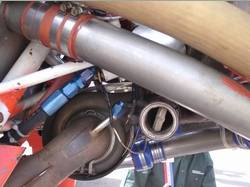Aero-Tips!
A good pilot is always learning -- how many times have you heard
this old standard throughout your flying career? There is no truer
statement in all of flying (well, with the possible exception of
"there are no old, bold pilots.")

Aero-News has called upon the expertise of Thomas P. Turner,
master CFI and all-around-good-guy, to bring our readers -- and us
-- daily tips to improve our skills as aviators. Some of them, you
may have heard before... but for each of us, there will also be
something we might never have considered before, or something that
didn't "stick" the way it should have the first time we memorized
it for the practical test.
Look for our daily Aero-Tips segments, coming each day to you
through the Aero-News Network.
Aero-Tips 07.31.06
 Turbocharged engines develop more
power than natural air pressure allows by compressing incoming air.
So if the turbo fails, just fly it as a normally aspirated engine
to a place where it can be fixed, right? Well...
Turbocharged engines develop more
power than natural air pressure allows by compressing incoming air.
So if the turbo fails, just fly it as a normally aspirated engine
to a place where it can be fixed, right? Well...
Turbo design
Most general aviation turbochargers consist of two parts, a
turbine and a compressor. The turbine is in the exhaust manifold
and the compressor in the induction manifold; exhaust gases spin
the turbine, which in turn rotates the compressor to increase air
flow.
Most also include a wastegate to control turbocharger output.
The wastegate determines the amount of exhaust gas that spins the
turbine by opening or closing to adjust the percentage of exhaust
that bypasses the turbocharger. Commonly a turbocharger uses engine
oil to automatically adjust the wastegate-increasing oil pressure
through a wastegate actuator closes the wastegate and increases
manifold pressure, while decreasing oil pressure results in a drop
in manifold pressure.
Turbo failures
An unexplained drop in manifold pressure may be a result of:
- Oil loss. Oil loss reduces pressure in the wastegate, reducing
turbo output. Reduced manifold pressure may be your first
indication of a catastrophic oil loss... and impending engine
failure.
- Compressor failure. If the compressor itself should become
damaged, for instance, by foreign object ingestion, it may restrict
the flow of "normally aspirated" air (I've heard stories of shop
rags and loose bolts being left in the engine compartment, entering
the induction manifold through an alternate air door and then being
ingested by the turbo). Power will drop below natural-air levels.
If the compressor breaks up, metal shards may enter the engine
itself, causing more damage or total engine failure.
- Exhaust leak. An exhaust leak can reduce turbine output,
dropping manifold pressure. Exhaust gasses may run as high as 1650
degrees F/899 degrees C or higher; if the leak is directed near a
fuel or oil line it can cause an engine fire.
There are other less catastrophic scenarios that can result in
an uncommanded loss of manifold pressure in turbocharged engines
(example: a pressure controller out of calibration). Trouble is,
from the pilot's seat there's no way you can distinguish the benign
scenarios from the danger of imminent engine failure or explosive
fire.
Aero-tip of the day: An unexplained loss of
manifold pressure in turbocharged airplanes is grounds for landing
at the very nearest runway, whether or not repair services are
immediately available. Do a precautionary engine shutdown if flying
a twin. Be prepared for a possible engine fire or failure.
 Airborne 05.10.24: Icon Auction, Drunk MedEvac Pilot, Bell ALFA
Airborne 05.10.24: Icon Auction, Drunk MedEvac Pilot, Bell ALFA ANN's Daily Aero-Term (05.13.24): ILS PRM Approach
ANN's Daily Aero-Term (05.13.24): ILS PRM Approach ANN's Daily Aero-Linx (05.13.24)
ANN's Daily Aero-Linx (05.13.24) Airborne-NextGen 05.07.24: AI-Piloted F-16, AgEagle, 1st 2 WorldView Sats
Airborne-NextGen 05.07.24: AI-Piloted F-16, AgEagle, 1st 2 WorldView Sats Airborne 05.08.24: Denali Update, Dad-Daughter Gyro, Lake SAIB
Airborne 05.08.24: Denali Update, Dad-Daughter Gyro, Lake SAIB




